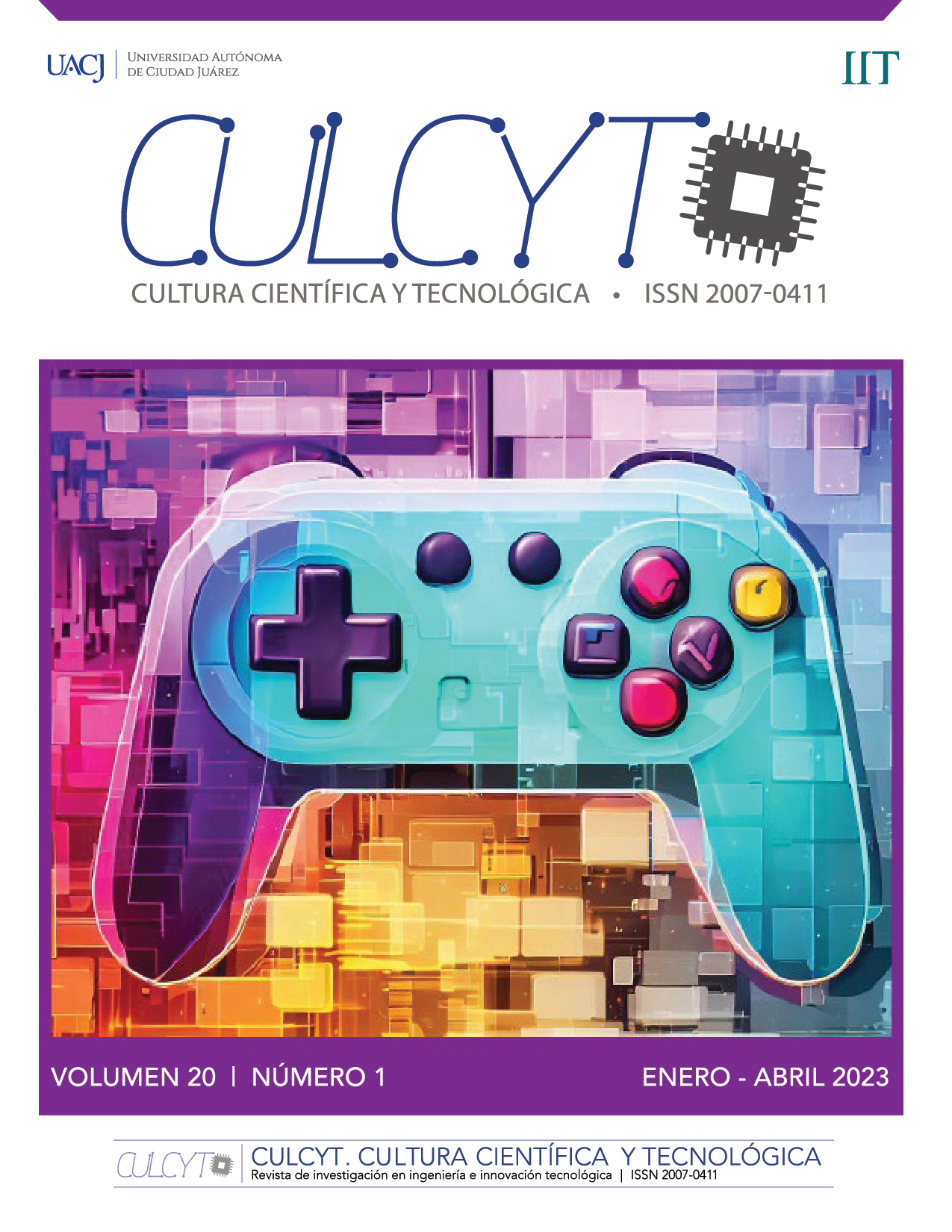Stress concentration reduction in an axially loaded rectangular bar with an elliptical hole
DOI:
https://doi.org/10.20983/culcyt.2023.1.2.2Resumen
Two-dimensional finite element analysis was used for stress concentration factors estimation in a wide range of bar-ellipse height and height-width elliptical hole ratios in a tensile bar. Least squares polynomial equations were fit to the design points. These equations agreed and tension stress concentration factor for elliptical holes was described. Such equation reproduces the curves and through its derivative the optimal values that minimize the concentration factor are estimated. The path of the minimal concentration factor was illustrated in a contour plot.
Descargas
Citas
K. Nanan. “4 Ways to Reduce Stress Concentration n Machone Parts.” Corrosionpedia.com, https://www.corrosionpedia.com/stress-concentration-top-four-tips-to-reduce-stress-concentration-in-machine-parts/2/7016 (accessed Dec. 10, 2021).
S. Nagpal, N. K. Jain, and S. Sanyal, “Stress Concentration and Its Mitigation Techniques in Flat Plate with Singularities - A Critical Review,” Eng. J., vol. 16, no. 1, pp. 1-16, 2012, doi: 10.4186/ej.2012.16.1.1.
C. Kirsch, “Die Theorie der Elastizität und die Bedürfnisse der Festigkeitslehre,” in Zeitschrift des Vereines Deutscher Ingenieure, vol. 42, 1898, pp. 797-807.
S. Lorente, J. Lee, and A. Bejan, “The ‘flow of stresses’ concept: The analogy between mechanical strength and heat convection,” Int. J. Heat Mass Transf., vol. 53, no. 15-16, pp. 2963-2968, 2010, doi: 10.1016/j.ijheatmasstransfer.2010.03.038.
C. E. Inglis, “Stress in a plate due to the presence of cracks and sharp corners,” Trans Inst Naval Archit, vol. 50, pp. 219-241, 1913.
Z. Yang, C.-B. Kim, C. Cho, and H. G. Beom, “The concentration of stress and strain in finite thickness elastic plate containing a circular hole,” Int J Solids Struct, vol. 45, no. 3-4, pp. 713-731, 2008, doi: 10.1016/j.ijsolstr.2007.08.030.
A. J. Durelli and K. Rajaiah, “Optimum hole shapes in finite plates under uniaxial load,” J. Appl. Mech., vol. 43, no. 3, pp. 691-695, 1979, doi: 10.1115/1.3424628.
W. D. Pilkey, D. F. Pilkey, and Z. Bi, Peterson’s stress concentration factors. Hoboken: John Wiley & Sons, 2020.
W. C. Young, R. G. Budynas, and A. M. Sadegh, Roark’s formulas for stress and strain. New York: McGraw-Hill Education, 2002.
E. Z. Stowell, Stress and strain concentration at a circular hole in an infinite plate. Washington, DC: National Advisory Committee for Aeronautics, 1950.
N. Troyani, C. Gomes, and G. Sterlacci, “Theoretical stress concentration factors for short rectangular plates with centered circular holes,” J. Mech. Des., vol. 124, no. 1, pp. 126-128, 2002, doi: 10.1115/1.1412849.
E. Sternberg and M. A. Sadowsky, “Three-dimensional solution for the stress concentration around a circular hole in a plate of arbitrary thickness,” J. Appl. Mech., vol. 16, no. 1, pp. 27-38, 1949, doi: 10.1115/1.4009891.
E. S. Folias and J.-J. Wang, “On the three-dimensional stress field around a circular hole in a plate of arbitrary thickness,” Computational Mechanics, vol. 6, pp. 379-391, 1990, doi: 10.1007/BF00350419.
C. She and W. Guo, “Three-dimensional stress concentrations at elliptic holes in elastic isotropic plates subjected to tensile stress,” Int J Fatigue, vol. 29, no. 2, pp. 330-335, 2007, doi: 10.1016/j.ijfatigue.2006.03.012.
A. Kotousov, “Effect of plate thickness on stress state at sharp notches and the strength paradox of thick plates,” Int J Solids Struct, vol. 47, no. 14-15, pp. 1916-1923, 2010, doi: 10.1016/j.ijsolstr.2010.03.029.
N. K. Jain and N. D. Mittal, “Finite element analysis for stress concentration and deflection in isotropic, orthotropic and laminated composite plates with central circular hole under transverse static loading,” Mater. Sci. Eng., vol. 498, no. 1-2, pp. 115-124, 2008, doi: 10.1016/j.msea.2008.04.078.
F. Darwish, M. Gharaibeh, and G. Tashtoush, “A modified equation for the stress concentration factor in countersunk holes,” Eur J Mech A Solids, vol. 36, pp. 94-103, 2012, doi: 10.1016/j.euromechsol.2012.02.014.
Y. Zhou, Q. Lin, J. Hong, and N. Yang, “Optimal design of functionally graded material for stress concentration reduction,” Structures, vol. 29, pp. 561-569, 2021, doi: 10.1016/j.istruc.2020.11.053.
P. Jaiswal, S. Makin, A. D. Dubey, G. Ghangas, and V. Goyat, “Analysis of stress concentration reduction around rounded rectangular slot with FGM ring,” Materials Today: Proceedings, vol. 50, part 5, pp 1953-1957, 2022, doi: 10.1016/j.matpr.2021.09.323.
P. Rani, D. Verma, and G. Ghangas, “Stress concentration analysis of functionally graded material coated elliptical inclusion under uniaxial tension,” Materials Today: Proceedings, 2022, doi: 10.1016/j.matpr.2022.09.602.
M. Zappalorto and P. A. Carraro, “An engineering formula for the stress concentration factor of orthotropic composite plates,” Compos. B. Eng., vol. 68, pp 51-58, 2015, doi: 10.1016/j.compositesb.2014.08.020.
R. D. Cook, Finite element modeling for stress analysis. New York: John Wiley & Sons, 1994.
Descargas
Publicado
Cómo citar
Número
Sección
Licencia
Derechos de autor 2023 José Alfredo Ramírez Monares, Leonel Gamboa Soto

Esta obra está bajo una licencia internacional Creative Commons Atribución-NoComercial 4.0.
Todos los contenidos de CULCYT se distribuyen bajo una licencia de uso y distribución “Creative Commons Reconocimiento-No Comercial 4.0 Internacional” (CC-BY-NC). Puede consultar desde aquí la versión informativa de la licencia.
Los autores/as que soliciten publicar en esta revista, aceptan los términos siguientes: a) los/las autores/as conservarán sus derechos de autor y garantizarán a la revista el derecho de primera publicación de su obra; y b) se permite y recomienda a los/las autores/as agregar enlaces de sus artículos en CULCYT en la página web de su institución o en la personal, debido a que ello puede generar intercambios interesantes y aumentar las citas de su obra publicada.



